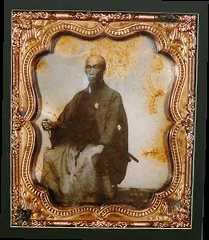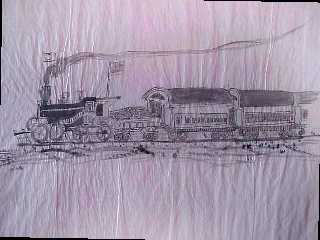|
佐藤藤七 (写真は、1860(万延元)年4月13日ワシントンで撮影)
Toshichi Sato (Photo taken in Washington, D.C. on June 2, 1860 or April 13 of Man'en 1 by Japanese calender)
この日同行した飛騨の加藤素毛の記録によると、「米側士官4人の案内により、従者方14人、伊勢屋3人で市中を散歩していたところ偶然目にした写真館に入って撮影した3点の写真のひとつ」。3点とは、このとき佐藤藤七、加藤素毛のほかに外国方御用達岡田平作手代の山本喜三郎が撮影したという。
1860(安政七・3月から万延元)年1月22日、日本を出発した遣米使節小栗忠順の従者として随行した権田村名主の佐藤藤七は、地球を一周して9月27日に帰国した。このときの体験をもとに書いた通称「渡海日記」と、「諸用留・しょようとどめ」が残る。
藤七は藤岡市本動堂(もとゆるぎどう)の出身。上野介の父小栗忠高に認められて権田の名主佐藤家に婿入りした。
According to the record of Somo Kato of Hida, who accompanied Sato on that day, "Fourteen attendants and three staff members of the Iseya group (a grocery supplier for the Shogunate) were strolling in the city with four American officers, when they happened to see a photo studio and took three photographs. The three people photographed were Toshichi Sato, Somo Kato, and Kisaburo Yamamoto, a servant of Heisuke Okada, a merchant who deliver goods to the Foreign Affairs Depeartment of the Shogunate.
On Februay 13, 1860 (or January 22 of Ansei 7 which became Man'en 1 after March), Toshichi Sato, the master of Gonda Village, accompanied Tadamasa Oguri, who left Japan on a mission to the U.S., as his attendant, and returned to Japan on November 9, 1860 (or September 27 of Man'en 1) after circumnavigating the globe. Based on his experiences, Sato wrote “Tokai Nikki (Diary of Crossing the Pacific Ocean)” and "“Shoyo-todome (Notes on Various Matters),” both of which remain today.
Toshichi Sato was born in Motoyurugido, Fujioka City, Gunma Prefecture. He was recognized by Tadataka Oguri, father of Tadamasa Oguri, and became a son-in-law of the Sato family, a village master in Gonda at the time.
|
|
藤七の地球一周の記録・通称 『渡海日記』
Records of Toshichi Sato's circumnavigation of the globe, also known as
the "Tokai Nikki (Diary of Crossing the Pacific Ocean)”
佐藤藤七の残した地球一周の記録。このとき54歳で使節に随行した。
1860(安政七・3月から万延元)年1月18日、江戸を出発して羽根田沖の米国軍艦ポウハタン号に乗り込むところから書き出し、太平洋横断・ハワイ・サンフランシスコ・パナマ・ロアノーク号でカリブ海を北上・ワシントン上陸・フィラデルフィア・ニューヨーク・ナイアガラ号で大西洋、インド洋を横断・インドネシア・香港・9月27日(日記では28日)江戸帰着までを記録した日記。
所々に極細の筆によって墨一色で描かれた絵が入っている。絵の描写は細かく、ハワイのカメハメハ王夫妻の表情、パナマで乗った汽車、動植物などがきわめて正確な描写で描かれている。
藤七個人の感想や批評の文は一切なく、客観的な文章に終始してコースと旅行の概略がつかめる内容となっている。このため、若干文章としての面白みに欠ける。
この日記は藤七が帰国後に、いろいろな人に外国の土産話をするに当って、まずこの「渡海日記」で、コースの概略や外国の様子をつかんでもらうために整理されたもののように思われる。現在日記は個人蔵。そっくりに書き写された別の写本は東善寺蔵。
Toshichi Sato was 54 years old when he accompanied the envoys to the U.S.
The diary begins on February 9, 1860 (or January 18 of Ansei 7 by Japanese calender) , when Sato left Edo (Tokyo) and boarded the USS Powhatan off Haneda. The diary goes on to record the following events: crossing the Pacific Ocean, calling at Hawaii and San Francisco and arriving at Panama on the Powhatan, heading north to the Caribbean on the USS Roanoke, landing in Washington, Philadelphia, New York, crossing the Atlantic and Indian Oceans on the USS Niagara, Indonesia, Hong Kong, and returning to Edo on November 9, 1860 (or September 27 of Man'en 1 which was noted as "November 28" in the diary).
In some places, there are pictures drawn in black ink with a very fine brush. The drawings are detailed, and include the expressions of King Kamehameha and his wife in Hawaii, the train they took in Panama, and the flora and fauna with extreme accuracy.
There are no personal comments or criticisms by Sato, and the text is entirely objective, allowing the reader to get an overview of the course and the trip. For this reason, it lacks some interest as a piece of writing.
This diary seems to have been compiled by Sato in order to give people a general idea of the course and the conditions of the foreign country when he gave them stories of his trip after returning to Japan. The diary is now in a private collection. Another exact copy of the diary is in the collection of Tozenji Temple.
|
|
1、渡米準備記録
小栗上野介は渡米の事前学習として、前年の秋安政6年10月4日横浜へ出かけ、コースや日程、持参品などについてアメリカ人船長ジョン・マーサー・ブルック大尉から聞いている。藤七は従者の一人としてこれに随行し、上野介とブルックの一問一答を書き留めることから、この記録ノート『諸用留』を書き出している。ブルック大尉はこの後10名の部下とともに咸臨丸に乗って太平洋横断航海を指導援助した。ブルックと通訳のジョン万次郎がいなかったら、咸臨丸は大嵐を乗り切ってサンフランシスコへ着くことはできなかったといえる。
2、『米利堅志・めりけんし』の写し
中国の地誌『米利堅志』を写して、米国についての概念を学習しようとしている。すべて漢文。
当時アメリカですでに手話によって聾唖者が会話をしていること、パナマに運河を造る計画があること、などがわかる。
3、英語単語ノート
「2月4日、この日から米人教師英学を始める」と渡海日記にあることから、ポウハタン号の船中でこの頃からはじまった英語の勉強の記録であろう。農民が学んだ振り仮名つきの英語単語帳として、注目される。
4、滞米中のメモ
アメリカ滞在中のメモなどが記録されている。
ドル銀貨の価値/ワシントンでの見聞/帰国に当って太平洋廻りを希望したが大西洋廻りになった経過/ジャワでの新聞報道「日本の最近の事件」「第2次アヘン戦争の記事」など。
5、渡米に当っての持参品
藤七の持参品リスト
1. Record of preparations for going to the United States: As a preliminary study for his trip to the U.S., Kozukenosuke Oguri went
to Yokohama in the autumn of the previous year, on October 29, 1859 (or
October 4 of Ansei 6), and heard from John Mercer Brooke, an American captain,
about the course, itinerary, and what to bring. As one of his attendants,
Toshichi Sato accompanied Oguri and wrote down each question and answer
between Kozukenosuke and Brooke, which led to the writing of this notebook,
"Shoyo-todome." Captain Brooke later assisted in guiding the
voyage across the Pacific Ocean aboard the Kanrin Maru with ten of his
men. Without Brooke and his interpreter John Manjiro, the Kanrin Maru would
not have survived the great storm and reached San Francisco.
2. A copy of “Merikenshi (Writing about the U.S.A.)”: Sato attempted to learn about the concept of the U.S. by copying the Chinese
geography book "Merikenshi." All the text is in Chinese. It shows
that deaf people were already using sign language to communicate in the
U.S. at that time, and that there was a plan to build a canal in Panama.
3. English Vocabulary Notebook: This is probably a record of the English study that started on board the Powhatan, since the diary says, "On February 4, I started English study with an American teacher." It is noteworthy as an English vocabulary book with furigana by a farmer who learned English at the time.
4. Memos while in the U.S.: This is a record of notes taken during his stay in the United States. The
value of a silver dollar coin, what he saw and heard in Washington, the
process of choosing the route to Japan by way of the Atlantic Ocean despite
that the deletation wanted to go through the Pacific Ocean, newspaper reports
from Java on "recent events in Japan" and "articles on the
Second Opium War."
5. Items he brought with him to the U.S.: List of items Toshichi brought with him to the U.S.
|

